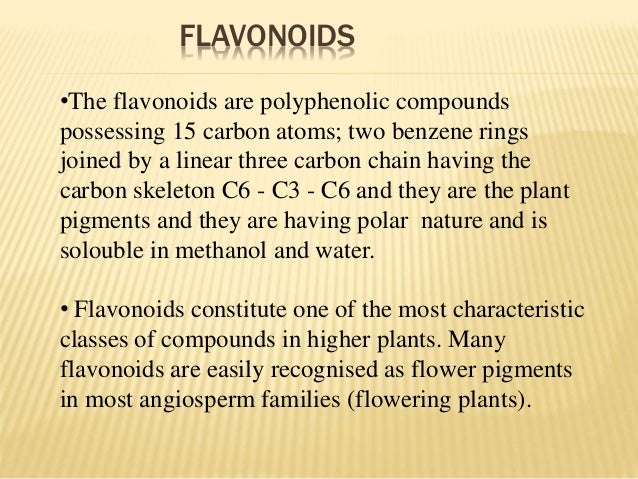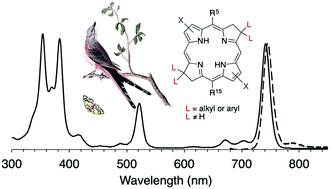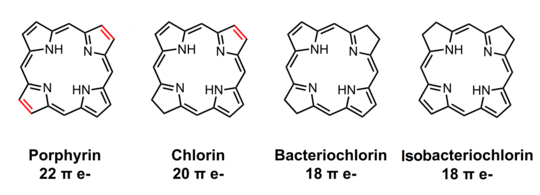Chlorins are porphyrins with one beta-saturated pyrrolic ring
destroying the p-conjugation at the beta-carbons. The saturation
of the beta-carbons e†ectively prevents the ring current from
taking the outer route at that particular pyrrolic unit. Since
chlorins have 24p-electrons, all p-electrons cannot directly
participate in the aromatic pathway. However, when one considers the aromatic pathway to be a superposition of several
22p-electron paths, all 24p-electrons can form the total aromatic pathway. For chlorins, pyrrolic rings with an inner
hydrogen have strong local ring currents. For and t-CH2
(a) cCH the pyrrolic ring without an inner hydrogen has a 2
(b),
NICS values which is twice as large as for the corresponding
unit in indicating a stronger local ring current (see t-PH2
,
Table 4). This can be explained by assuming that the aromatic
pathway consists of a superposition of two 22p-electron pathways. In for example, the two 22 t-CH p-electron routes 2
(a),
consist of six p-electrons from one aromatic pyrrolic ring with
an inner hydrogen, Ðve p-electrons from the pyrrolic ring
without an inner hydrogen, four p-electrons from the meso
carbons, four p-electrons from the outer path of the other pyrrolic ring with an inner hydrogen, and three p-electrons from
the inner path of the b-saturated pyrrolic ring. Another 22pelectron path consists of the two pyrrolic rings with an inner
hydrogen, and the inner paths at the two other pyrrolic rings.
For the NICS value for the pyrrolic ring without an c-CH2
,
inner hydrogen is only 2.8 ppm, indicating that the inner
paths at the pyrrolic rings without an inner hydrogen is the
dominating one. For the chlorins with an inner hydrogen connected to the b-saturated ring, the ring current is signiÐcantly
weaker than for the other chlorins. For and t-CH2
(a) c-CH2
(a),
the obtained current susceptibilities are 7.4 and 7.2 nA T~1,
respectively, while for the two other chlorins the corresponding values are 4.6 and 4.9 nA T~1.
Bacteriochlorins have 22p-electrons and consist of four pyrrolic rings of which two are b-saturated. The two transFig. 8 (a) The 18p-[16]annulene internal cross pathway, (b) the traditional 18p-[18]annulene pathway, (c) the most important 22pelectron pathway and (d) the 26p-electron aromatic pathway for
t-PH2bacteriochlorins have large current susceptibilities, while the
current susceptibility for and is 5.3 and 3.1 c-BCH2 t-IBCH2 nA T~1, respectively. The aromatic pathway for con- t-BCH2
(a)
sists of two aromatic pyrrolic rings with an inner hydrogen
and the inner path at the b-saturated rings yielding a 22pelectron pathway. For the pyrrolic rings without an t-BCH2
(b),
inner hydrogen have large local ring currents. The aromatic
pathway for consists of the two aromatic pyrrolic t-BCH2
(b)
rings without an inner hydrogen and the inner paths at the
b-saturated rings. Since for the current must pass t-BCH2
(b),
two inner hydrogens the ring-current susceptibility is 7.8 nA
T~1 as compared to 9.2 nA T~1 for has t-BCH2
(a). t-BCH2
(a)
current susceptibility almost as large as It is question- t-PH2
.
able whether with a current susceptibility of 3.1 nA t-IBCH2 T~1 can be considered aromatic.
D. t-3BCH and 2
, t-4BCH2 t-PH2
(m)
The molecules have three t-3BCH b-saturated pyrrolic rings 2 yielding 20 p-electrons. The only possible current pathway
consisting of (4n ] 2) p-electrons is the 18p-[16]annulene
inner cross path. The current susceptibilities for the studied
t-3BCH molecules are only 2.5 and 3.3 nA T~1, respectively, 2 which indicates that they are not particularly aromatic. Energetically, lies lower than since the t-3BCH2
(a) t-3BCH2
(b),
unsaturated pyrrolic ring with an inner hydrogen is much
more aromatic than the pyrrolic ring without the inner hydrogen. Hence, is more stable than which t-3BCH2
(a) t-3BCH2
(b),
does not have any inner hydrogen connected to the bsaturated ring. The molecules do not have a signiÐ- t-3BCH2 cant 18p-[16]annulene inner cross aromatic pathway.
The current susceptibility of of 7.2 nA T t-4BCH ~1 is of 2 the same size as for and For the t-CH2
(a) c-CH2
(a). t-4BCH2 ,
only possible aromatic pathway is the 18p-annulene inner
cross path. As expected, has a smaller ring-current t-4BCH2 radius than the other porphyrins studied. is also the t-4BCH2 only molecule among the studied ones which has a signiÐcant
18p-[16]annulene inner cross aromatic pathway. The reason
is that the porphyrins in general are stabilized by the local
aromaticity of the pyrrolic rings, and their aromaticity would
be weakened by the 18p-[16]annulene pathway. In t-4BCH2
,
all pyrrolic rings are non-aromatic and the 18p-[16]annulene
aromatic pathway stabilizes the molecule energetically.
In Table 2, it can be seen that is the most destabi- t-4BCH2 lized molecule as compared to the other porphyrins. Even
though has a relatively strong ring current, it lies t-4BCH2 energetically high. The hydrogenation energy is 79.3 kJ mol~1
larger when two hydrogens are added to than when t-3BCH2
(a)
two hydrogens are added to yielding The t-PH2 t-CH2
(a).
general trend for the hydrogenation of the b-carbons for the
porphyrins is that the energy gain decreases with the number
of b-saturated rings.
The molecule has a very large current radius, since t-PH2
(m)
the two pyrrolic rings with an inner hydrogen simulate a
global ring current. The saturated meso carbons prevent the
global ring current, which is also reÑected on the ARCS value.
From the NICS values in Table 4 one can see that the rings
without an inner hydrogen are not particularly aromatic,
which indicates that the pyrrolic rings without an inner
hydrogen need the conjugated p-electron environment in
order to sustain a local ring current. The obtained current
susceptibility for is 3.0 nA T t-PH ~1, which shows that the 2
(m)
contribution from the pyrrolic rings to the ARCS values of the
porphyrins is in general much smaller than the contribution
from the porphyrin loop.
VI. Summary
The present study shows that the total aromatic pathway of
porphyrins must be considered as a superposition of several
pathways. For porphin, all 26p-electrons are part of the aromatic pathway. The pathway must be considered mainly as a
superposition of the 26p-electron path and two 22p-electron
paths. For chlorins, all 24p-electrons participate in the aromatic pathway, which implies that the total aromatic pathway
must be considered to consist of a superposition of 22pelectron paths. For bacteriochlorins, all 22p-electrons are
involved in the aromatic pathway.
The b-unsaturated pyrrolic rings in porphyrins have local
ring currents which are intergraded parts of the total aromatic
pathway. The current strength of the pyrrolic rings with an
inner hydrogen is of about the same size as for the free pyrrole
molecule. Pyrrole rings without an inner hydrogen have signiÐcantly smaller local ring currents than the rings with an
inner hydrogen. The porphyrins are energetically stabilized by
the aromaticity of the pyrrolic rings.
The 18p-[16]annulene inner cross aromatic pathway does
not exist in porphyrins until all pyrrolic rings are nonaromatic. This means that the units of the pyrrolic rings C2
H2 do not function as exocyclic bridges. We also found that the
1H NMR shieldings of the inner hydrogens correlate well with
the calculated current susceptibilities, and thus can be used as
an experimental measure for the aromaticity of free-base
porphyrins.





